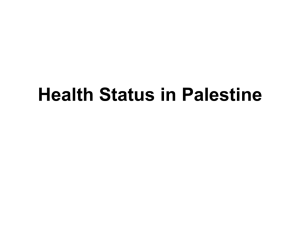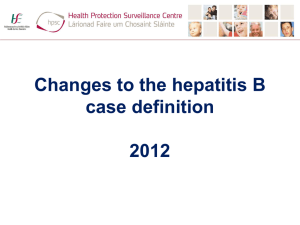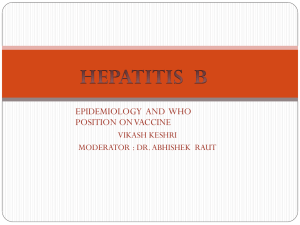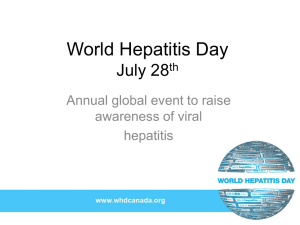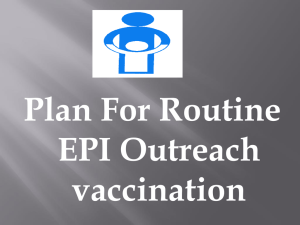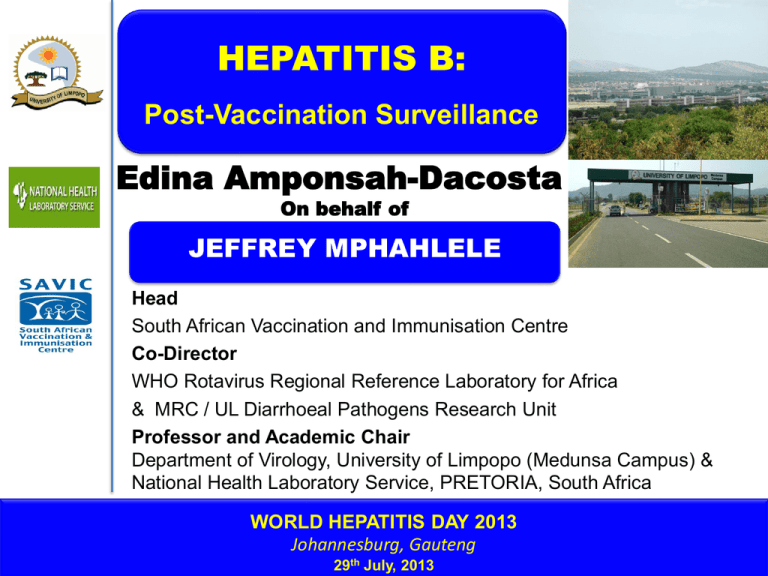
HEPATITIS B:
Post-Vaccination Surveillance
Edina Amponsah-Dacosta
On behalf of
JEFFREY MPHAHLELE
Head
South African Vaccination and Immunisation Centre
Co-Director
WHO Rotavirus Regional Reference Laboratory for Africa
& MRC / UL Diarrhoeal Pathogens Research Unit
Professor and Academic Chair
Department of Virology, University of Limpopo (Medunsa Campus) &
National Health Laboratory Service, PRETORIA, South Africa
WORLD HEPATITIS DAY 2013
Johannesburg, Gauteng
29th July, 2013
OUTLINE
• Introduction of hepatitis B vaccine into NIPs
• Methods to evaluate impact of hepatitis B
vaccination
• Short-term vs. long-term measure of impact of
vaccination
– Examples of representative nationwide sero-surveys of
impact of hepatitis B vaccination
• Concluding Remarks
Introduction of hepatitis B vaccine into
NIPs
● Hepatitis B vaccine is the first vaccine against cancer
– Available since the early 80’s
– Prevents >0.5 million deaths/year from acute and chronic
hepatitis B virus (HBV) infection
Recommendation by WHO (1994)
– Hep B vaccine should be introduced into NIPs:
o Countries with HBsAg prevalence 8% by 1995
o Global introduction by 1997
– South Africa was among the first 10 countries to introduce
hepatitis B vaccine on the African continent (April, 1995)
WHO/UNICEF Estimates
• Huge discrepancies between immunization
coverage estimates reported by NDoH/EPI
unit and those published by WHO/UNICEF
• Routinely collected immunization coverage
data is still not completely reliable and cannot
as yet be used to accurately monitor coverage
or infer vaccine impact
Hepatitis B prevention programme
and monitoring vaccine impact
POSTVACCINATION
SURVEILLANCE
Monitor Impact
Evaluate programme effectiveness
Ensure sustainability
Identify resources & implement vaccine
Develop comprehensive prevention strategy
Assess and quantify disease burden
Define epidemiology of disease
Challenges in monitoring impact of
hepatitis B vaccination programme
● Hepatitis B is grossly under-diagnosed and
under-reported
− difficult to quantify and assess burden of infection
− difficult to quantify and assess burden of disease
● To assess impact of vaccination
− measure the burden of disease or burden of infection?
Comparison of methods to evaluate
impact of hepatitis B vaccination
Coverage
Survey
Sero-survey
Acute
Disease
Surveillance
Morbidity
& Mortality
Feasibility
+
+++
+++
+++
Expense
+
+++
+++
++
Frequency of
evaluation
I*
I
I or C*
I or C
-
+++
+++
+
+++
+
+++
Prevalence
of
infection
Incidence
new
infection
Incidence
chronic
sequelea
Program effectiveness
short-term
long-term
Information
collected
Coverage
data
Risk factor
information
* I=intermittent;
C=continuous
Sero-surveys to assess impact of
hepatitis B vaccination programme
● Sero-surveys in targeted cohorts
– Short-term measure of impact of vaccination
– Targeted cohorts: Vaccinated cohorts
– Ideally, first survey within 2-5 years of start of
programme
– Periodic surveys thereafter (e.g., every 5 years)
Short-term measure of impact of
hepatitis B vaccination
Studies in targeted populations
(Vaccinated Cohorts) to assess
effectiveness of the vaccine
1. Increase in protection in vaccinated cohorts
2. Reduction in hepatitis B chronic carriage
THE FIRST 5 YEARS OF HEPATITIS B VACCINATION
Tsebe et al, Vaccine 2001; 19: 3919 - 3926
• Objectives were to assess the:
- immunogenicity of hepatitis B vaccine in the field
- the effectiveness of immunisation in reducing HBsAg carriage in <5 yrs
• Cross-sectional, first five years of vaccination [1995-1999]
• 598 babies were recruited in Limpopo Province:
-
age range: 8 - 72 months
mean age: 23.3 months
-
M:F ratio was approx. 1:1 (304 : 294)
• Inspected Road-to-Health cards to ascertain the babies
received 3 doses of 1.5 g/0.5ml Hepaccine-B (Cheil)
• HBsAg, anti-HBs, and anti-HBc, and when necessary, HBeAg,
anti-HBe, and HBV DNA were tested
National Survey of the Effectiveness of Hep B Vaccine
Schoub et al, Bull of WHO 2002; 80 (4): 277 - 281
• In 1999, NDoH and NICD, conducted National Survey of
the effectiveness of hep B immunisation in South Africa
• Study design
- cross-sectional
• 770 babies were recruited from rural areas in 9
provinces
-
-
Sampling period: Feb - Nov 1999
healthy 18-months-olds
vaccinated at 6, 10 and 14 weeks of life
• HBsAg, anti-HBs, and anti-HBc were tested
Effectiveness of hepatitis B vaccine within EPI-SA:
Two independent studies
Tsebe et al, 2001
Schoub et al, 2002
Mean age (months)
23.3
(8 months - 5 yrs)
Anti-HBs positivity
(>10 mIU/ml)
86.8% (N = 519)
HBsAg positivity
0.0%
(N = 578)
0.4%
(N = 756)
Anti-HBc positivity
0.9%
(N = 582)
0.5%
(N = 770)
•
•
18
87.0% (N = 769)
[95.6% for 8-12 mo (n = 153 )]
Schoub et al, Bull of WHO 2002; 80 (4): 277 - 281
Tsebe et al, Vaccine 2001; 19: 3919 - 3926
Protective Efficacy of Hepatitis B vaccine within EPI (SA):
Comparison of three (3) field studies
Tsebe et al,
2001
Mean age (months)
Schoub et al,
2002
HIV-ve
HIV+ve
TOTAL
11.9
10.9
11.4
(5 - 24 mo)
(5 - 24 mo)
(5 - 24 mo)
87.0%
(N = 769)
85.7%
(N = 230)
78.1%
(N = 73)
83.8%
(N = 303)
0.0%
(N = 578)
0.4%
(N = 756)
0.4%
(N = 230)
2.7%
(N = 73)
0.9%
(N = 303)
0.9%
(N = 582)
0.5%
(N = 770)
2.7%
(N = 230)
3.0%
(N = 73)
2.9%
(N = 303)
23.3
18
(8 mo - 5 yrs)
Anti-HBs positivity
(>10 mIU/ml)
Simani et al, 2009
86.8%
(N = 598)
95.6% for
8-12 mo (n = 153)
HBV chronic
carriage
(HBsAg positivity)
Anti-HBc positivity
Schoub et al, Bull of WHO 2002; 80 (4): 277 - 281
Tsebe et al, Vaccine 2001; 19: 3919 – 3926
Simani et al, Vaccine 2009; 27: 140-151
Effect of Routine Infant Immunization on
the
Prevalence of Chronic HBV Infection
Study
No.
Year Tested
268
Samoa
1995
1994
1996
Lombok
Alaska
Taiwan
Age
(yrs)
Chronic HBV infection
Vaccine Before After
Coverage Program Program
424
435
1-10
7-10
7-8
96%
73%
87%
16%
10%
7%
0.0%
1.1%
0.5%
1994
2519
4
>90%
6.2%
1.9%
Ponape
1994
364
3-4
82%
NA
1.0%
Micronesia
1992
544
2
40%
12%
3.0%
South Africa1 2001
578
1-5
74%
10%
0.0%
South Africa2 2002
756
1-2
74%
10%
0.4%
Long-term measure of the impact of
hepatitis B vaccination
Population-based studies to assess
immunity and chronic carriage to HBV
1. Has vaccination influenced population immunity?
2. Has vaccination influenced the epidemiology of
HBV?
• Hepatitis B chronic carriage?
Amponsah-Dacosta et al, Medunsa, unpublished
data
Demographics of study population
Sex (%)
Mean age
Post-Vaccine Intro.
1-16 years
(n=635)
(standard
deviation)
Male
Female
Unknown*
8.7 years
(4.9)
276
(49.2%)
350
(50.5%)
9
(0.3%)
Provinces
(No. of samples)
Gauteng (689)
North West (408)
Pre-Vaccine Intro.
17-25 years
(n=571)
21.9 years
(2.4)
131
(23.3%)
Total (N=1206)
17 years
(7.2)
407
(33.7%)
*Subjects’ gender not recorded
439
(76.5%)
1
(0.2%)
Mpumalanga (63)
Limpopo (47)
789
(65.4%)
10
(0.8%)
Northern Cape (1)
Has hepatitis B
vaccination influenced
population immunity?
Immunity (anti-HBs alone;≥2 mIU/mL) to
hepatitis B
57.0%
p < 0.0001
13.0%
(post-vaccine introduction)
(pre-vaccine introduction)
Detectable immunity (anti-HBs alone) within
the post-vaccine introduction population
76.1%
50.0%
46.3%
6.4%
Has population hepatitis
B chronic carriage
decreased?
Immunity (anti-HBs alone;≥2 mIU/mL) and
hepatitis B chronic carriage (HBsAg)
57.0%
p=0.003
13.0%
1.4%
4.2%
(post-vaccine introduction) (pre-vaccine introduction)
Immunity (anti-HBs alone; ≥2 mIU/mL) and
chronic carriage (HBsAg) in the post-vaccine
introduction group
76.1%
50.0%
0.5%
1.3%
46.3%
2.2%
Highlights from the study
1. 17 years of universal hepatitis B vaccination has been a
remarkable success
– Population immunity to HBV is high (57.0%)
– Chronic carriage is significantly reduced in the population
2. However, the observation that chronic carriage
increases as immunity wanes sparks the debate for a
pre-adolescence hepB vaccine booster
3. A representative nationwide hepatitis B sero-survey is
recommended to better ascertain the long-term impact
of universal hepB vaccination in South Africa
Key issues for conducting nationwide
sero-surveys of the impact of hepB vaccine
1. Timing of survey relative to introduction of
vaccination programme
2. Age group of interest
3. Sampling procedure
4. Sample=Blood
5. Human resources
6. Laboratory vs. point‐of‐care tests
7. Laboratory testing algorithm
8. Ethical considerations
Inherent limitations associated with
sero-surveys
• Good approach for measuring the burden of infection but:
– requires representative samples
– often conducted in convenient populations, not representative
for the general population
• children visiting health centers (e.g. EPI clinics)
• pregnant women, armed force recruits, blood donors, etc
• Other limiting factors include:
– need for a blood sample
– Time-consuming, expensive
– Most important factor: laboratory capacity
Concluding Remarks
• There is evidence for elimination of chronic carriage in
vaccinated cohorts – Short-term impact
− Averting future HBV related liver disease, cirrhosis, HCC and death
• Almost 17 years after vaccine introduction, there is also
evidence for shifting HBV epidemiology in the
population – Long-term impact
− Increased population immunity to, and reduced chronic carriage of, HBV
• There is a need for a representative nationwide serosurvey to assess the long-term impact of universal
hepatitis B vaccination in South Africa.



